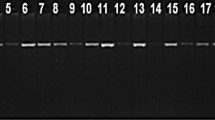Abstract
Nap Hal, an Indian landrace of wheat, exhibited unique characteristics suitable for biscuit making quality. Double null trait at Glu-D1 locus in Nap Hal was associated with reduced gluten strength as reflected in low sedimentation volume (16.0 ml, 6 g test), lower Farinograph peak time (2.0 min) and lower tolerance (higher break down 140 BU) to mixing. PCR analysis of puroindoline genes showed the presence of both pinA and glycine type pinB associated with soft grain texture of wheat. This is the first report that Nap Hal contains unique combination of soft grain characteristics determined by puroindolines as well as low gluten strength determined by null alleles at Glu-D1 locus. The combination of both soft grain characteristics and weak gluten is useful in developing varieties suitable for biscuit making where the use of chemical improvers can be reduced.
Similar content being viewed by others
References
MacRitchie F, Advances in cereal science and technology, Vol III (Y Pomeranz, Editor), American Association of Cereal Chemists, St Paul, MN (1980), pp 271–326.
Giroux MJ & Morris CF, Theor Appl Genet, 95 (1997) 857.
Sewa Ram, Boyko E, Giroux MJ & Gill BS, J Plant Biochem Biotech, 11 (2002) 79.
Payne P, Nightangle M, Krattiger AF & Holt LM, J Sci Food Agri, 40 (1987) 51.
Bietz JA, Shepherd KW & Walls JS, Cereal Chem, 52 (1975) 513.
Lawrence GJ, MacRitchie F & Wrigley CW, J Cereal Sci, 7 (1988) 109.
AACC, Approved Methods of American Association of Cereal Chemists, 10th edition. The Association: St Paul, MN, USA (2000).
Dick JW & Quick JS, Cereal Chem, 60, (1983) 315.
Czuchajowska Z, Lin PY & Smolinski S, Cereal Chem, 73(3) (1996) 338.
Singh NK, Hephers KW & Cornish GB, J Cereal Sci, 14 (1991) 203.
Benito C, Figueiras AM, Zaragoza C, Gallego FJ & de la Pena A, Plant Mol Biol, 21 (1993) 181.
Sewa Ram, J Plant Biochem Biotech, 12 (2003) 151.
Sreeramulu G & Singh NK, J Cereal Sci, 20 (1994) 217.
Matuz J, Cereal Res Commun, 26 (1998) 203.
Finney PL, Gaines CS & Andrews LC, Cereal Foods World, 32 (1987) 313.
Zounis S. & Quail KJ, J Cereal Sci, 25 (1997) 185.
Sewa Ram & Singh RP, Cereal Chem, 81(1) (2004) 128.
Sewa Ram, Dawar V, Singh RP & Jag Shoran, J Cereal Sci, 42 (2005) 261.
Greenwell P & Schofield JD, Cereal Chem, 63 (1986) 379.
Gautier MF, Aleman ME, Guirao A, Marion D & Joudrier P, Plant Mol Biol, 25 (1994) 43.
Author information
Authors and Affiliations
Corresponding author
Rights and permissions
About this article
Cite this article
Ram, S., Shoran, J. & Mishra, B. Nap Hal, an Indian Landrace of Wheat, Contains Unique Genes for Better Biscuit Making Quality. J. Plant Biochem. Biotechnol. 16, 83–86 (2007). https://doi.org/10.1007/BF03321979
Received:
Accepted:
Published:
Issue Date:
DOI: https://doi.org/10.1007/BF03321979




